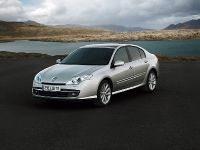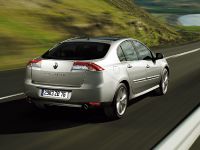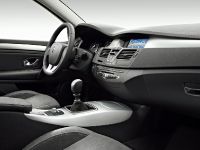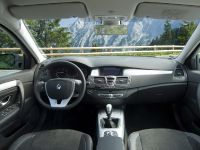Renault Laguna
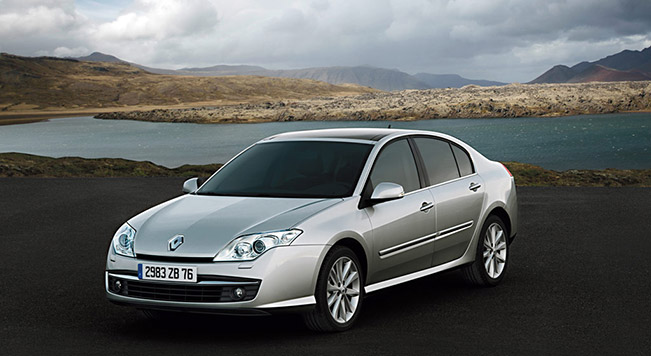 Renault Laguna : born under the sign of quality Since it was fi rst launched in January 1994, more than 2.3 million of the fi rst two generations of Laguna have been sold. Laguna is manufactured in the Sandouville factory in France with a level of quality never seen before.
Renault Laguna : born under the sign of quality Since it was fi rst launched in January 1994, more than 2.3 million of the fi rst two generations of Laguna have been sold. Laguna is manufactured in the Sandouville factory in France with a level of quality never seen before.
Preparing for Renault's return to the luxury car segment, Laguna has been manufactured to be both robust and reliable. The stated objective is to be in the top three of its segment for product and service quality.
Driving pleasure…
Laguna was designed from the outset to give true driving pleasure. It has a dynamic, streamlined and elegant form, positioning it naturally in the realm of grand tourers, with an even more exclusive and distinctive profi le for the Sport Tourer. Its class-leading dynamic performance is a benchmark. Its chassis is responsive and its steering is particularly precise. Whilst being bigger and more spacious than its predecessor, Renault Laguna is notably lighter by an average of 15 kg and is available with a wide range of powerful and economical engines from launch, all with six-speed manual and automatic gearboxes.
…complete peace of mind
Laguna provides a real sense of peace of mind for all its occupants. In terms of protection, it benefi ts from Renault's acclaimed real-world accident knowledge and all of the latest technologies, in particular, side impact with an innovative thorax double airbag. The sophisticated air conditioning system offers class-leading thermal comfort. Equally, much attention has been focused on Laguna's acoustics which are again top-of-the-class. With an economical and ecological ‘Renault eco2' version, Laguna dCi 110 hp only consumes 5.1 litres per 100 km on a combined cycle, or 136 g of CO2 emissions per km. Laguna is respectful of the environment right from its production through to the end of its lifecycle. Laguna will be launched from 12 October 2007 as the future reference point for the family saloon segment in terms of usage, maintenance and repair costs.
Driving pleasure…
Renault Laguna has been manufactured with the aim of offering real driving pleasure. Its benchmark performance on the road is fi rst class. The car offers top driving comfort through its fi ne-tuned chassis and needle-sharp steering. It has an optimal weight distribution with a range of engines and gearboxes which offer high performance while being economical with fuel. A reactive chassis
Developed to go beyond the dynamic qualities for which its predecessor was recognised, the Laguna's chassis offers outstanding roadholding around bends. The steering is more sensitive to the touch, while maintaining its suspension quality through its vertical dampening. Renault's engineers have paid particular attention to the exact nature of the trajectory and the roadholding qualities of the car's body.
One characteristic of its turning capability is the specifi c roll which characterises the turning angle taken by the car visà- vis the road. With the Laguna, it is 1.9° (the segment average is 2.2°) for a transversal acceleration of 5m/s2. This situation corresponds to driving conditions on a winding road or at a roundabout outside of the city with a diameter of 400 m, driven at a speed of 60 km per hour.
The front axle is the pseudo McPherson type. The diameter of its anti-roll bar has been increased from 19.5 to 24 mm. Light and compact, the supple rear axle is in the form of an H, with anti-roll bars varying in diameter from 28.8 to 30.5 mm. The springs are 20% stiffer at the front and 50% stiffer at the rear, resulting in better control during vertical movements – without the vehicle being too sporty.
Renault Laguna is still astonishingly comfortable, thanks to greatly improved suspension: in association with helicoidal springs of varying fl exibility, the dampeners are pressurised at the front and in the form of bi-tubes at the rear. The reinforcements are situated at the appropriate points in the body, strengthening the body mass and increasing the capacity to withstand impact: in short, impeccable reliability.
Three tyre sizes are available according to the engine size : 16 inches in three widths: (195 and 205/60, as well as 215/55), 17 inches in 215/50 and 18 inches in 225/45, for heightened performance.
Precise steering
The accuracy of the steering is based on a reduced steering ratio and a stiffened steering column, with an aim to offer the driver more driving pleasure through the steering.
With a ratio of 1/16e (i.e. a 16° angle of the wheel for a 1° angle of the steering wheel), driving movements are rendered easier and the car becomes more agile. The increased stiffness and the systematic tracking and reduction of clearance give the driver more direct, accurate contact with the road, reducing response time between the steering wheel and the change of direction. The reduction of vibration arising from imperfections on the road surface has improved driving pleasure as a consequence. All the powerful engines or those equipped with particulate fi lter offer variable hydraulic assistance.
As a fi rst for Renault in the segment, Laguna inaugurates a new generation of assistance, through the utilisation of a driven electric pump unit (PEG). Available with the main petrol and diesel engines with manual gearbox, it allows the driver to obtain assistance through the use of the electric pump output, in accordance with the driving conditions. This output depends on the speed and the level of assistance required (speed and angle of the steering wheel) which allows an optimal fuel consumption, by driving the pump electrically when necessary. For the 1.6 16v petrol version, there is constant hydraulic steering assistance.
Even lighter and more aerodynamic
Lighter, on average by 15 kg (up to 65 kg on the 110 hp eco² diesel version), Laguna benefi ts from an outstanding weight distribution. It is the fi rst Renault vehicle to be lighter than its predecessor. A key ingredient in its driving pleasure, the weight distribution is a key factor on several different levels: dynamic performance (road holding, acceleration, roll during bends), fuel consumption and CO2 emissions, active safety (shorter braking distance) and passive safety (resistance in the case of impact). More than 300 actions have been listed and carried out by engineers, qualifi ed in their various fi elds, to attain this result.
New Laguna's performance, both dynamic and economic, is also linked to work carried out on mock-ups to optimise its aerodynamics. This was carried out in the wind tunnel and by digital simulation. These efforts have resulted in New Laguna's position at the top of the saloon market, with an SCx of 0.645 m² and a Cx of 0.293. (The SCx is the product of the frontal S surface of the vehicle by the air penetration coeffi cient, Cx). This progress is especially impressive for vehicles with raised modularity (hatchback) compared with a "saloon" or "notchback".
It is all the more signifi cant for Renault Laguna Sport Tourer, with a SCx of 0.696 and a Cx of 0.316, bearing in mind that the average SCx of all saloon cars on the market is 0.70 and the Cx, 0.315. These achievements have been rendered possible by the quality of the changes made and the work on the design of the rear lateral line and the door mirrors, which are, however, bigger in order to comply with the new regulations. As a fi rst for Renault, there is a discreet, integral fairing on the undercarriage which optimises the air fl ow while protecting the chassis.
